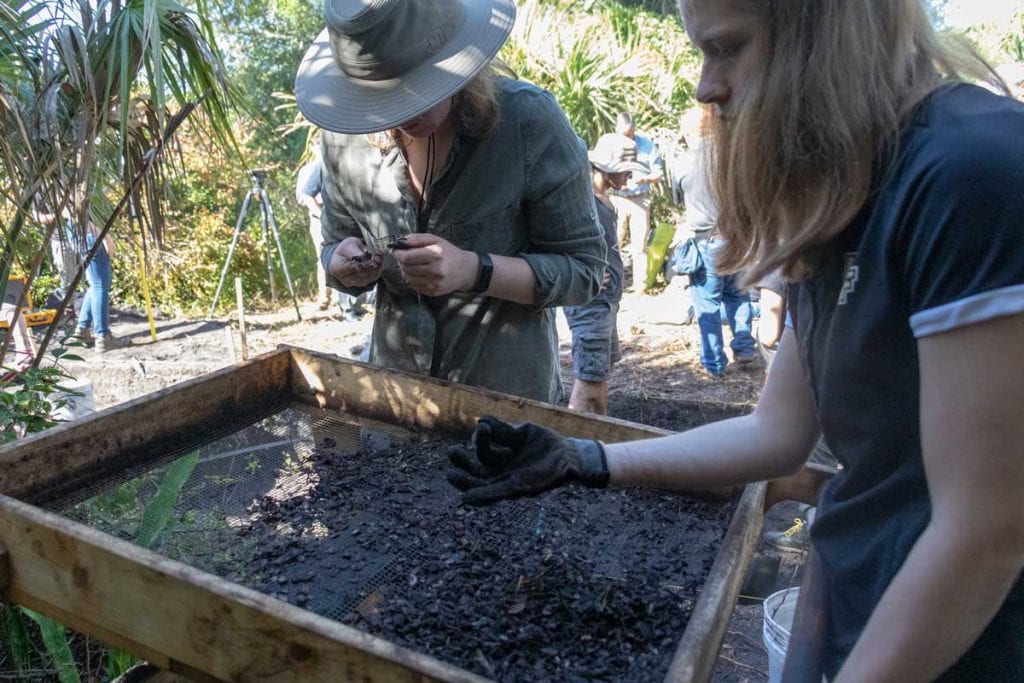UCF Researchers Uncover Florida’s Past Before It’s Lost to the Sea

BY ROBERT WELLS
As Florida’s Space Coast moves into the future, University of Central Florida archaeologists are taking a look back at some of the historic sites there before they succumb to erosion and rising seas.
“People don’t realize how interesting it is and how valuable it is for our institutional and social memory to have knowledge of places like these,” says Stacy Barber, a UCF archaeologist whose students are helping excavate sites at the Cape Canaveral Air Force Station. “Societies that don’t have a memory of the past perhaps don’t appreciate the value of the natural resources that are around them, and they misunderstand the capabilities that the local environment can provide.”
The work is part of a project with the Air Force’s 45th Space Wing and two Florida universities, including UCF, called the Cape Canaveral Archaeological Mitigation Project. The goal is to help the Air Force collect and preserve as much as possible before the sea reclaims the area in an estimated 20 to 25 years.
Meanwhile, the project gives UCF students invaluable field experience. UCF students participate as part of a spring anthropology internship class and work on the site twice a week.
“This program is one of the few in Florida where we’re working hard to give students primary professional experience during the regular semester for the price of a regular class,” Barber says. “There’s no extra cost, except commuting.”
Marketable Skills
Barber said archaeology typically has a high barrier to entry because it requires field training, which can be an expensive commitment. The field experience here will give participants a leg up when they enter the job market.
“Many students can’t take six weeks of their summer off from a job to learn how to do archaeology at a remote location, so here we are less than an hour from Orlando and our students are just taking this class like a regular class,” she says. “They’re getting this professional experience in a way that enables them to also hold jobs, care for family members, things our students need to be able to do.”
Cape Canaveral’s Many Roles
Today the Cape is known more for its rocket launches. But it has always been an attractive spot for humans. Not only was it the site of Native American burial mounds and settlements dating back to before 1,000 B.C., it was also home to some of the earliest European settlers on the East Coast.
Burial sites, settlements, the original Cape Canaveral lighthouse and a historic hotel are among the places being studied at Cape Canaveral Air Force Station.
On a recent dig day, UCF students and researchers were excavating in square pits deep in the brush, near a burial mound. From the earth, the students pulled fragments of pottery, shells, and bones from fish, indicating the location was perhaps a place for meals.
“What we’re really eager to see is how people were using this area,” Barber says. “We think it is probably feasting, maybe some kind of ceremonial ritual next to the burial mound, but we can’t say for certain until we can get some good hard data, and that’s going to come out of these pits this season.”
The Native Americans who inhabited the area were known as the Ais and were part of the Malabar culture. The first permanent European settler on Cape Canaveral was Captain Mills O. Burnham, who was also the first permanent lighthouse keeper.
Unlike many archeological sites on Florida’s West Coast, Barber says these East Coast sites are almost completely unstudied.
Tom Penders, the station’s archaeologist, helped facilitate the connection with UCF and says they are racing against time to document and digitally preserve the history there.
“This site has historic archaeology and pre-Columbian archaeology significance,” Penders says. “And with climate change and sea level rise, these sites will be gone in the next 20 to 25 years. We’re going to be the last archaeologists to look at these sites. So, we need to tell the whole story about them.”
The research team also included Neil Duncan, an assistant professor of archaeology at UCF, and Amanda Groff ’03 ’07MA, an associate lecturer of archaeology at UCF. Students from the University of South Florida also participate in the project.
Barber is an associate professor of anthropology at UCF. She received her doctoral and master’s degrees in anthropology from the University of Colorado at Boulder and her bachelor’s degree in anthropology from Harvard University. She joined UCF in 2007 and is a member of UCF’s Coastal Cluster.
Learning about the past and how its resources were used may very well help the Space Coast community forge its future, Barber says.
“That’s why it matters,” she says.
